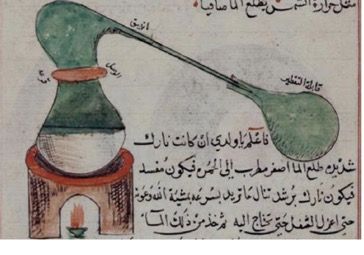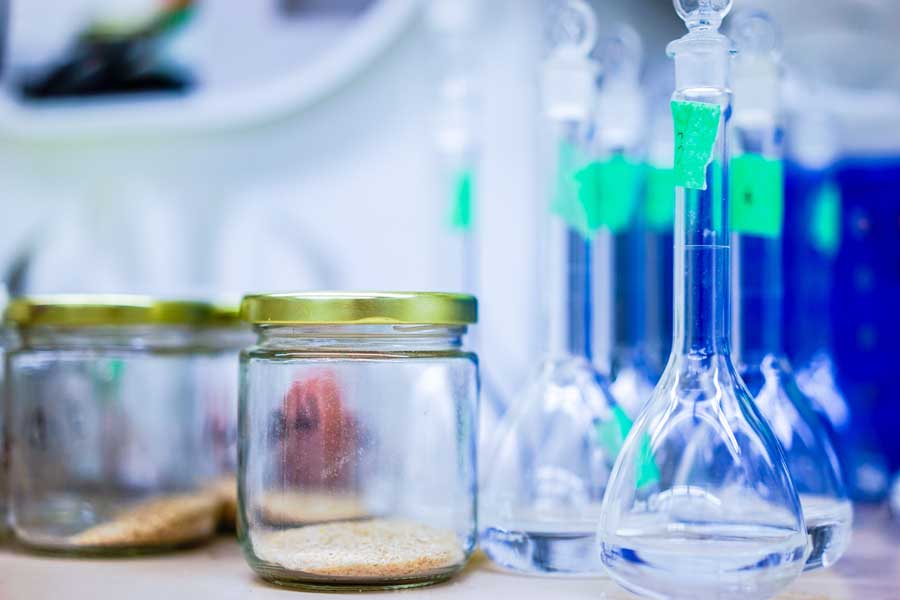The Arabic word for chemistry is alchemia, from which the English word, alchemy, is derived. During the Islamic Golden Age, alchemy was seen more as the investigation of chemicals in nature rather than the traditional view of alchemy as sorcery. A common view of alchemy is that it aimed to transform base metals such as lead into “noble metals” such as gold. However, a prominent alchemist during the 8th century, Jabir ibn Hayyan, used a systematic method to test metals, their general properties, and their chemical reactions. Jabir is known by many as the first scientist of the Islamic Golden Age. He is also commonly known as the father of Arab chemistry and according to an article, Jabir ibn Hayyan, in the Annals of Saudi Medicine, posted on the National Institutes of Health website, National Library of Medicine, Jabir is “credited with the introduction of experimental methodology into alchemy.” Jabir was the court alchemist during the rule of khalif Haroun Al-Rashid. In addition to pursuing chemistry, Jabir was also a physician and his work in this field contributed to the development of modern medicine.
It is estimated that Jabir wrote 300 books on philosophy, 1300 on mechanical devices, and hundreds of books on alchemy. Two of his notable works on chemistry are Kitab al-Zuhra and Kitab al – Kimya. These books were translated into Latin and widely popular in Europe. One of Jabir’s manuscripts consisted of his studies on the reactivity of specific metals with sulfur.
A key aspect to chemistry is the ability to isolate chemical compounds from a solution in order to carry out reactions. This is often used to remove impurities from metals and transform them through purification. Jabir used filtration, distillation, crystallization, sublimation, and evaporation in his work. The most prominent is distillation, and a still, an apparatus for distilling liquid mixtures, has been used as early as 4000 BCE. Jabir refined and improved a distillation tool and in Arabic it is called the alembic. The alembic was used commonly by Golden Age scientists. The primary purpose of an alembic, and distillation in general, is separating a soluble substance, which can be easily dissolved in water, from a solvent, or a base, which performs the dissolving, such as water. Through the alembic, the entire mixture is heated, evaporated, and condensed, separating the solute from the solvent. Using the alembic, scientists were able to purify gold and mercury. The alembic was used to produce pure alcohol, sulfuric acid, and other substances which would be used for medical purposes. Today, distillation is used for major world industries such as oil refining, water purification, and pharmaceuticals.
Another major accomplishment of Jabir which is well known to chemists today, is his discovery, of aqua regia. Aqua regia is a mixture of hydrochloric acid (HCI) and nitric acid (HNO3). It’s interesting how the two acids in aqua regia cannot dissolve gold by themselves but only when mixed together. If gold was mixed into nitric acid alone, some of its atoms would bounce off and others would join back to the metal through an equilibrium. Therefore, although there would be atomic movement, there would not be any physical movement of the gold dissolving. When adding HCI to the HNO3, the chlorine ions block ions from going back to the metal. This inability to maintain an equilibrium causes gold to dissolve.

Alembic sketch from the Islamic Golden Age
Photo credits: ResearchGate
In addition to purifying metals and substances, Jabir also synthesized many acids such as hydrochloric, nitric, citric, acetic, and tartaric. Jabir discovered hydrochloric acid by heating salt and sulfuric acid. Hydrochloric acid, which is used in the aqua regia mixture, is also used for neutralization as a strong acid. Jabir discovered nitric acid by heating potassium nitrate with sulfuric acid. Nitric acid, which is also used in the aqua regia mixture, is used for treating indigestion, producing fertilizers, and dyes. Acetic acid is contained in vinegar. Tartaric acid lowers the pH level which can kill bacteria.
The word “alkali” was first introduced by Jabir ibn Hayyan and derived from the Arabic word al-qaliy (the calcined ashes). Alkaline is a strong base which is used to neutralize acids. Indigestion tablets are an example of one of alkali’s medical usages. These tablets are alkalis of magnesium hydroxide and magnesium carbonate. When this reacts with the acidity created by the excess hydrochloric acid in the human stomach, it creates a neutralization reaction.
Jabir ibn Hayyan is a name that is often overlooked when discussing the origins of chemistry. It is important to honor the discoveries and dedication of the Golden Age scientists in their efforts which laid the foundation and contributed to modern day chemistry. Jabir’s work has inspired so many scientists after him who further advanced chemistry in both the Arab world and Europe. His legacy is one which has had its influence on many industries such as medicine and pharmacy, steel, dyes, and glass making. According to the article mentioned above, “the development of chemistry in Europe can be traced directly to Jabir ibn Hayyan.”






